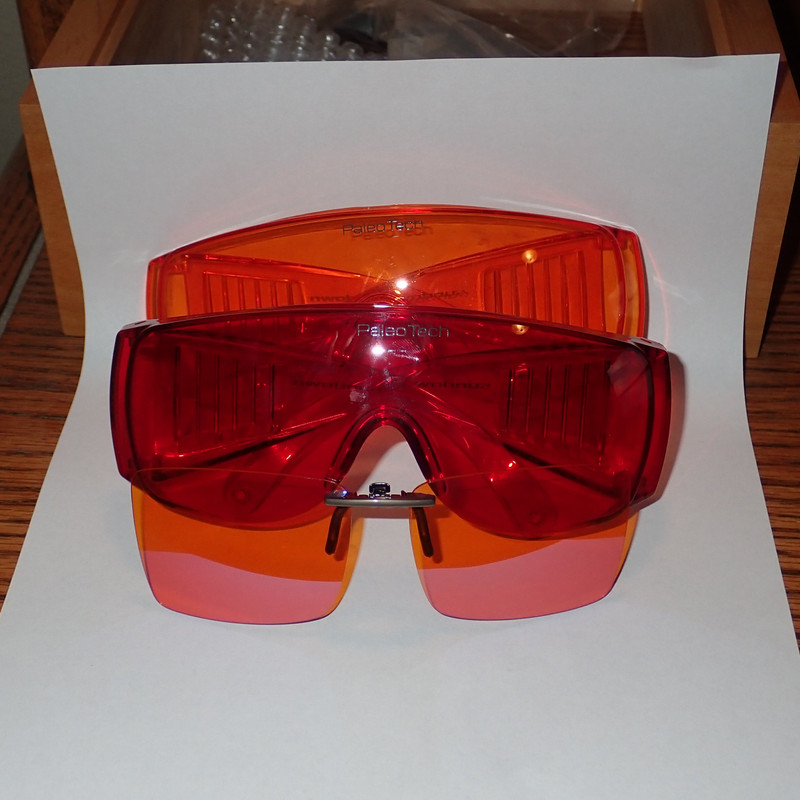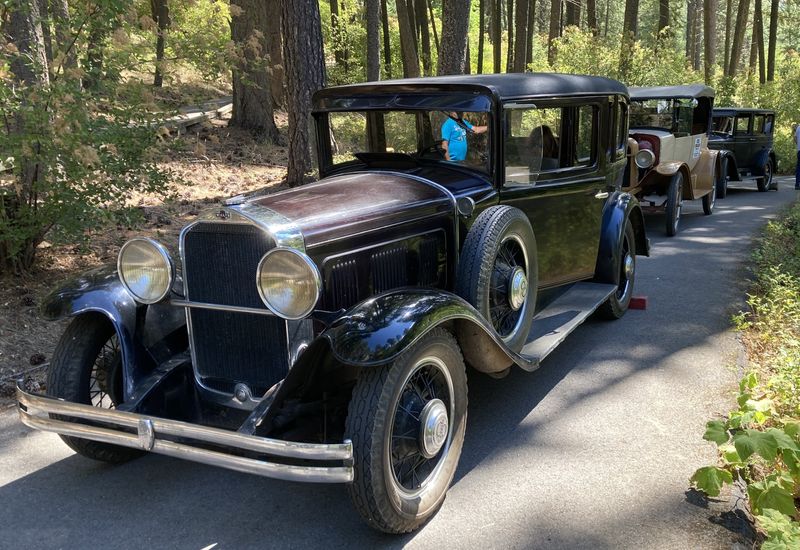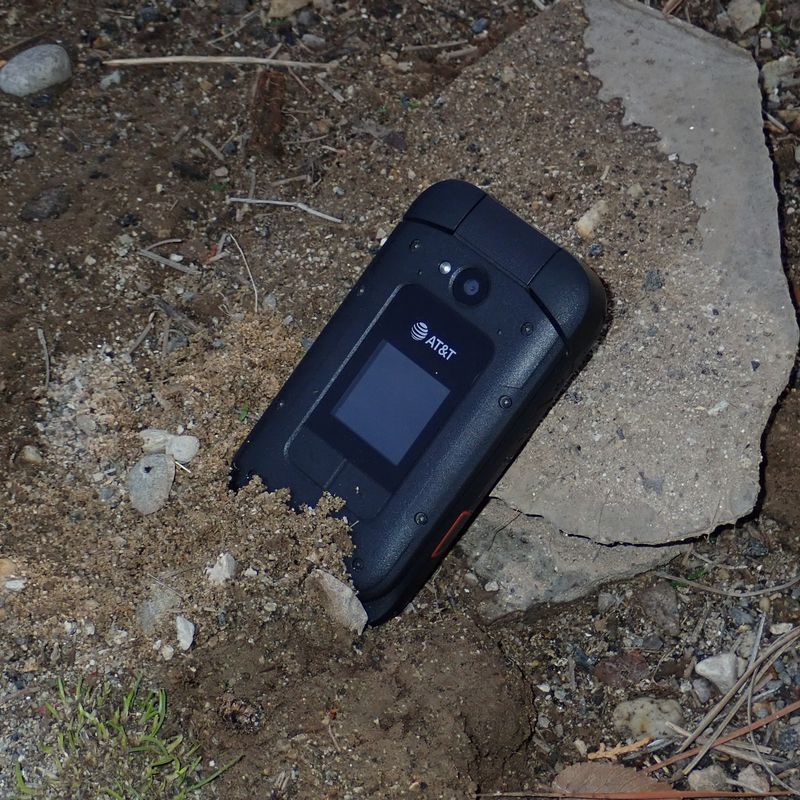Some of my recent posts have been on light bulbs and blue, looking at LEDs as well as incandescents. But what about computers, various “night shift” modes, and the suggested “blue light blocker” glasses out there that claim to help us sleep? Do they work? How much blue do the glasses block when actually looking at a computer screen?
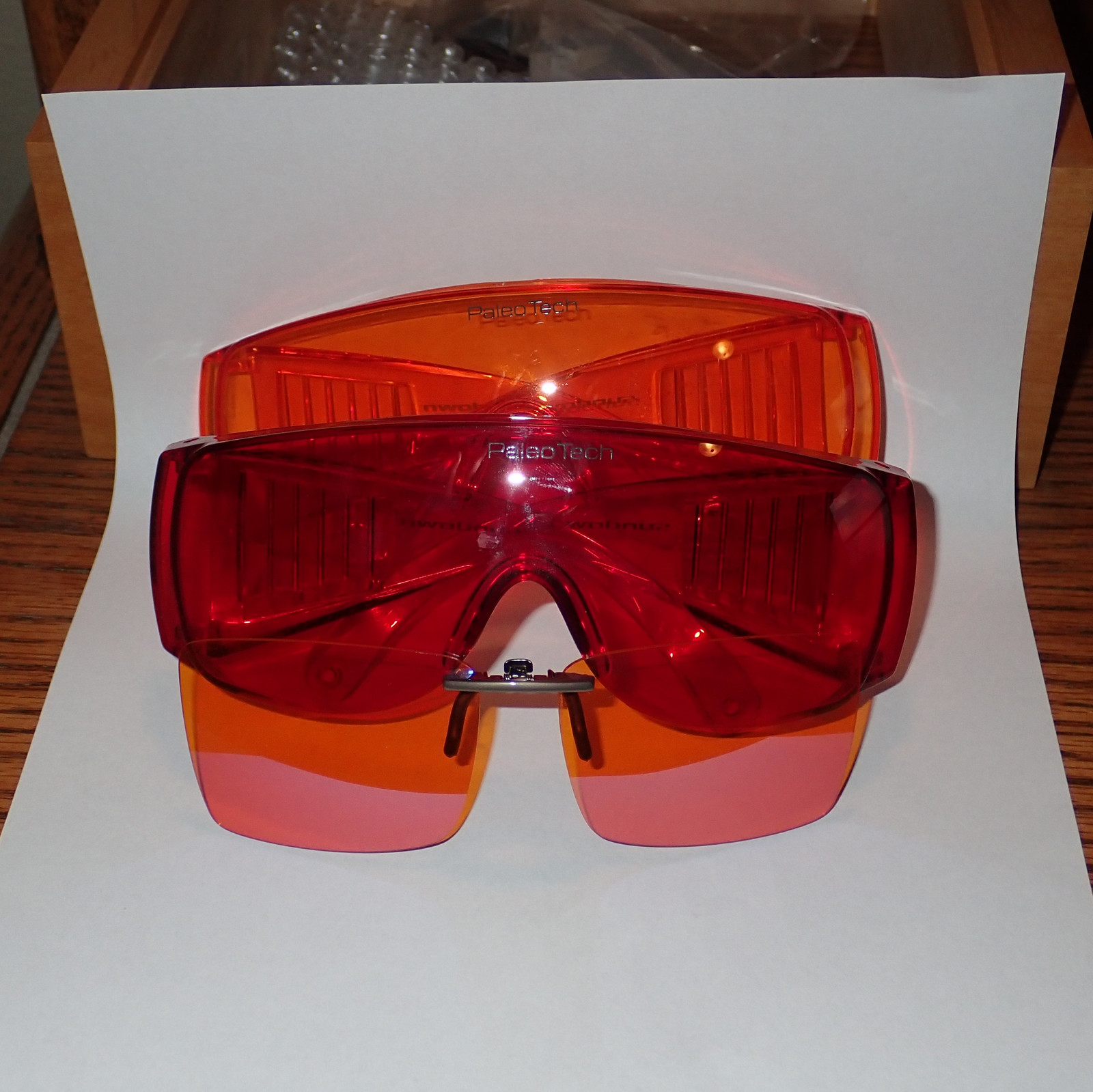
This week, I’m looking at exactly that set of questions, based around two easily available monitors to me. I’m using the house desktop, which is an Ubuntu install and a HP Z27n monitor, and then my Thinkpad X250 running Qubes.
Night Shift: Ubuntu and Z27n
Most devices these days include some sort of “redshift for night” feature that reduces the blue and goes on about how you should enable this to help you sleep. It drops the color temperature and looks somewhere between “orange” and “very red,” depending on the features you use. On MacOS and Windows, f.lux is the usual solution, and on Linux, some distros have a built in feature, otherwise you can usually use redshift to accomplish the same result.
They certainly appear to drop the amount of blue, but they also don’t do a good job of eliminating it, and given how bright and close laptop and desktop screens tend to be, my personal experiments indicate that they don’t do an awful lot of good. At least for me.
My HP Z27n, showing a white image, looks like this. You can easily see the blue, green, and red peaks, though the red is a fatter range. My meter’s sensitivity does drop off here in the reds, but you can still see the shape of the spectrum.
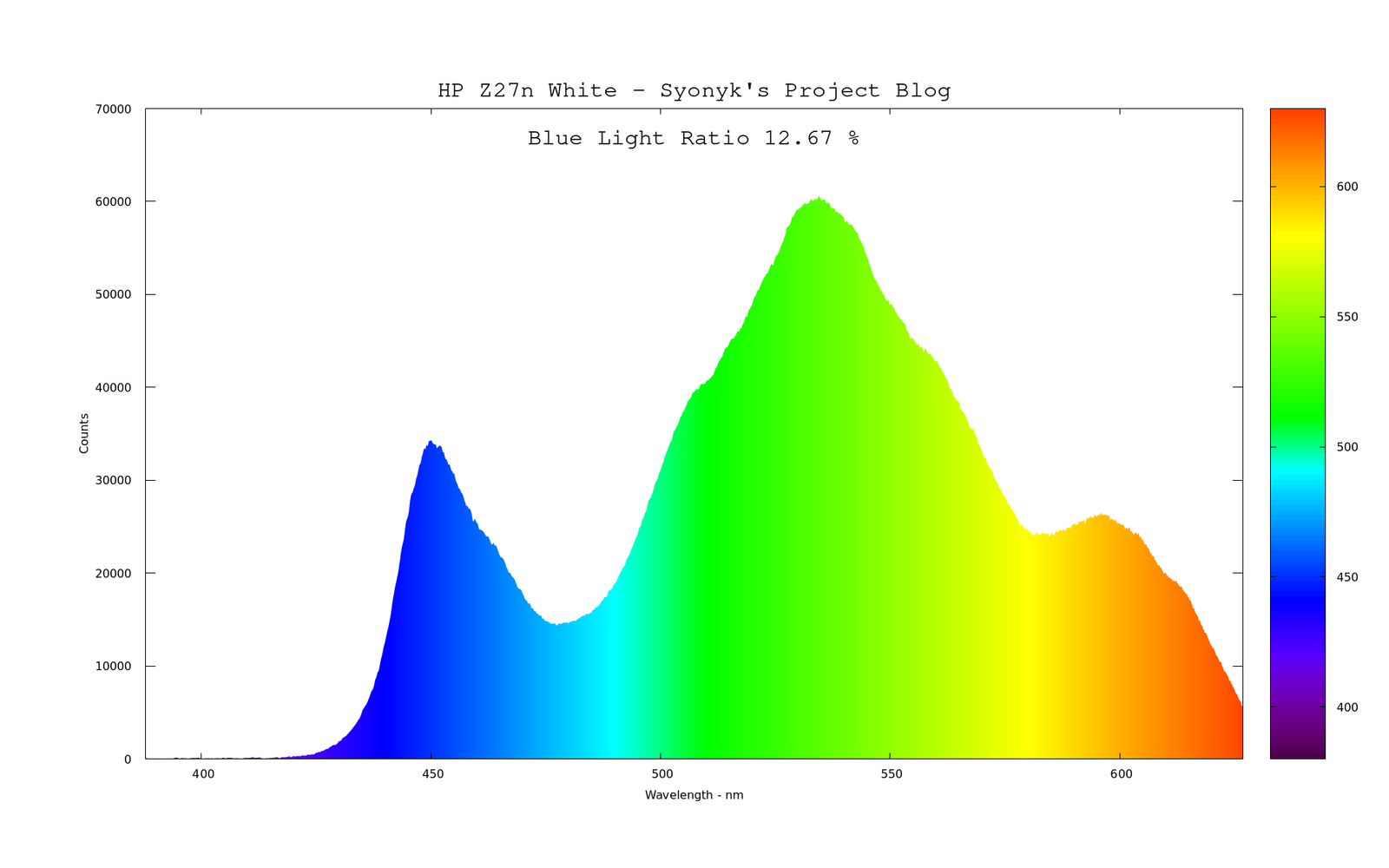
Throw Ubuntu’s Night Light on with maximum warm settings, and the blue drops a lot - but there’s still a decent amount down there, as one would expect for showing a range of color tones. It’s certainly better - but neither do I think it’s quite good enough, based on experimentation with my sleep.
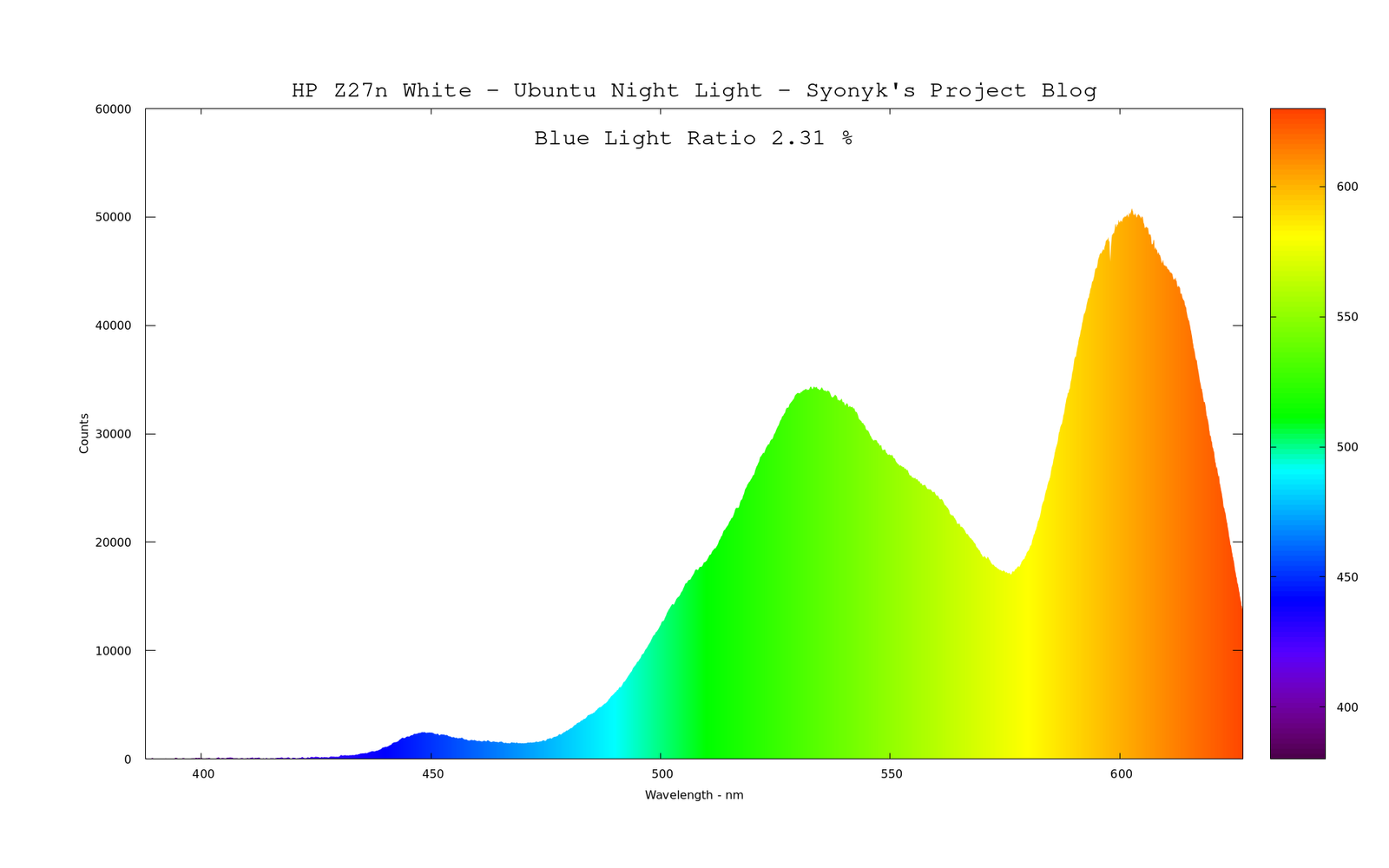
Red Shift: ThinkPad X250
My other test machine here is a ThinkPad X250. It doesn’t even get to run Ubuntu - it runs Qubes, and among other features it lacks is a built in nightshift. Full white on the screen gives this sort of spectrum - again, nothing particularly weird for an RGB screen, though if you wonder why some laptops are better at colors than others, the shape of these curves matters.
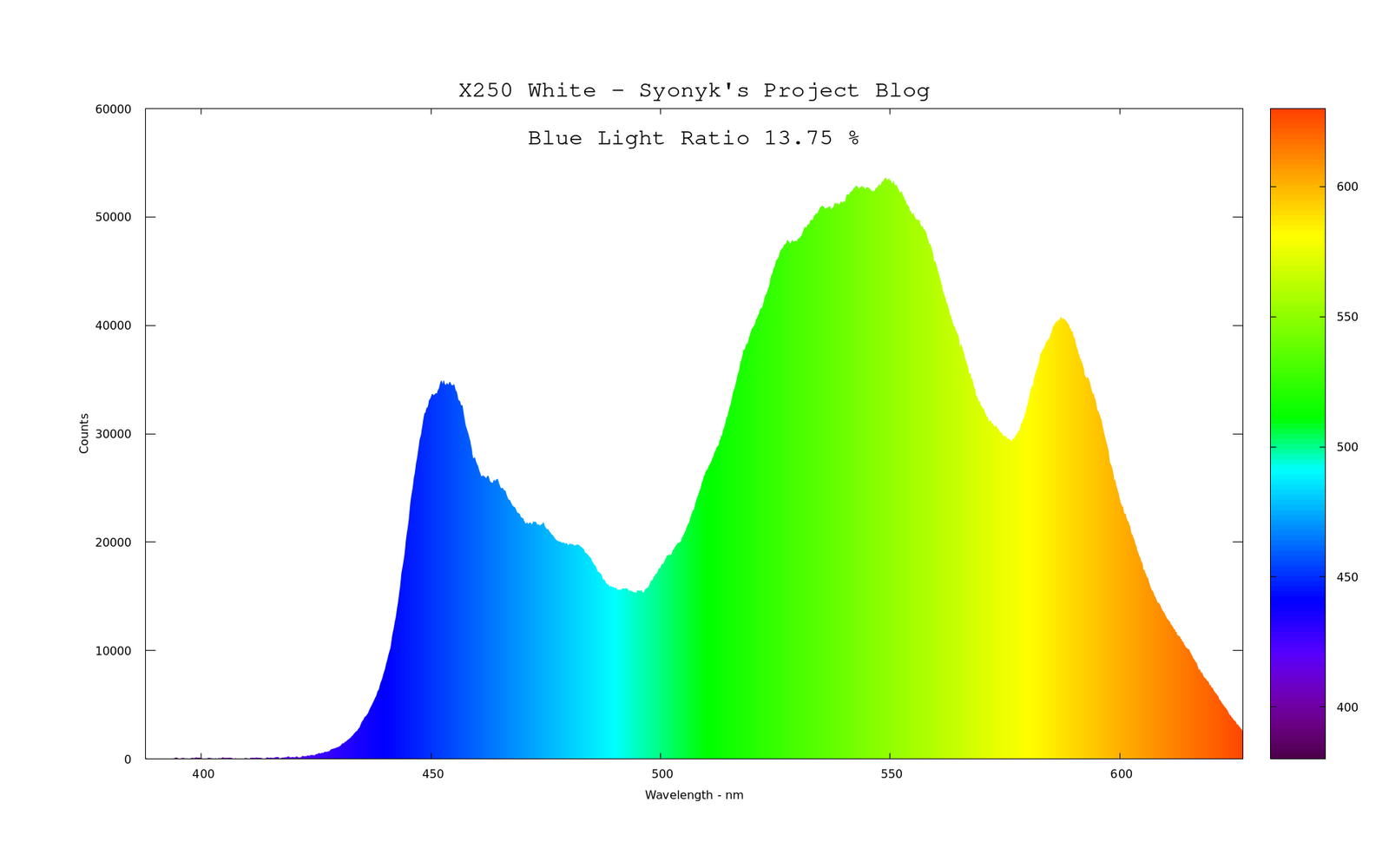
On Qubes, or various other distros, something like redshift -P -O 1000 will redshift your screen hard - it’s aiming for a 1000K color temperature, and that’s the lowest you can set. The “-P” parameter clears any existing gamma curves before setting new ones, and should you want to return to the pain of blue, redshift -x will do the job. Unlike Ubuntu’s night shift, this really gets rid of a lot of the greens as well. The screen isn’t “monochrome red,” but neither is it particularly far from that. It’s red ehough to make the charts quite difficult to read in this mode. But, still, there’s a decent amount of blue light remaining. Remember, laptop screens (and phones, tablets, etc) are all typically closer to your face and a lot brighter than ambient room lighting - so it doesn’t take as much blue to screw with things. I’ve been using night shift and the like for years, and I’ve concluded during these experiments that, at least for me, it’s almost worthless.
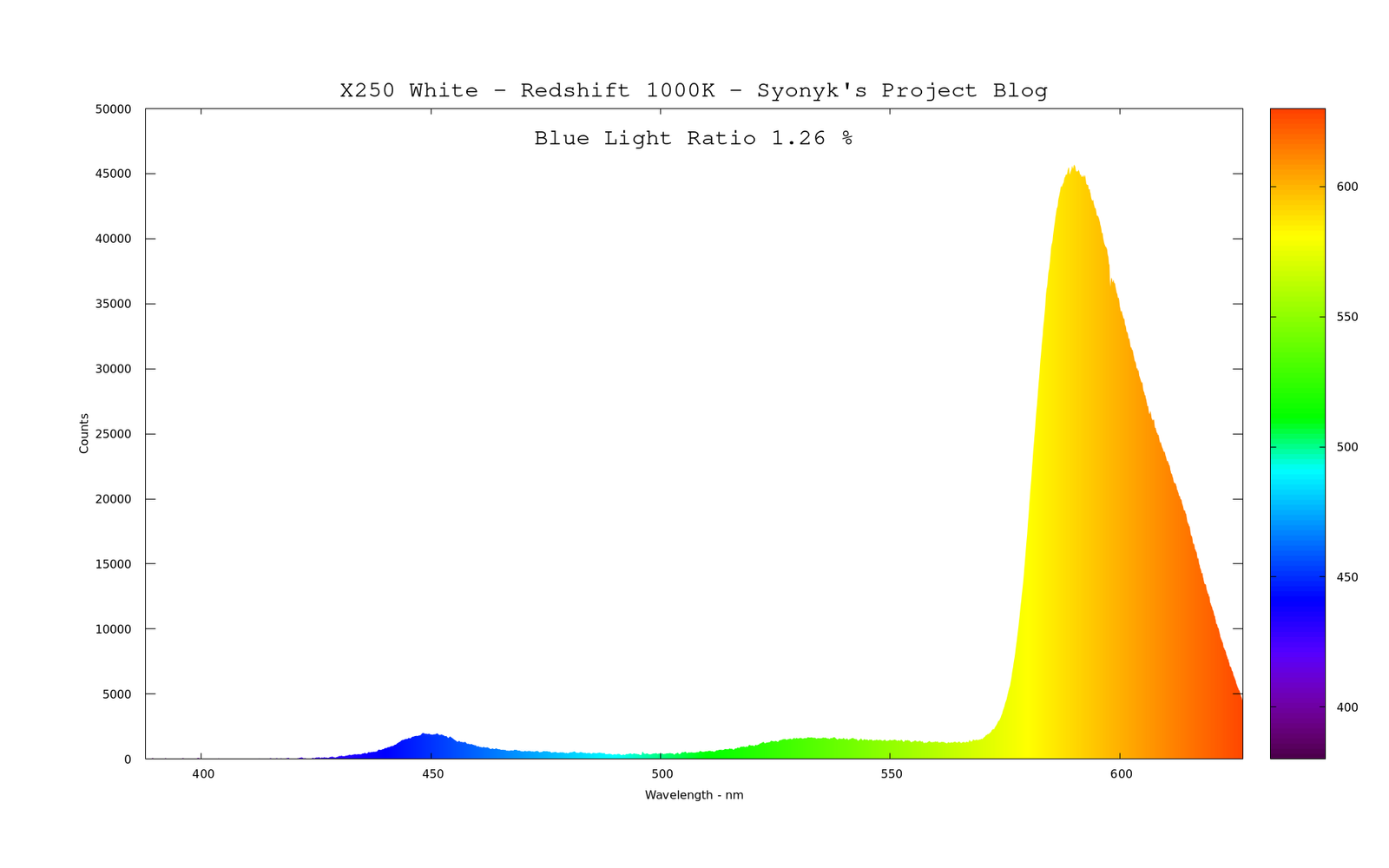
Vyzia Orange Clip-Ons
I’m starting out with the Vyzia Night Sleep clip-ons, because they’re the best I’ve evaluated - and I want to show you how everything else compares to these. You can find these on Amazon, eBay, or their webstore (and if you’re picking up a set, my previous links do kick me a bit back - I purchase almost everything on my blog out of my own pocket to review). These come with a nice hard case and are clip ons - so if you don’t wear glasses, well… sorry, I don’t think these will work for you. But if you do, and you want something useful at night, get these.
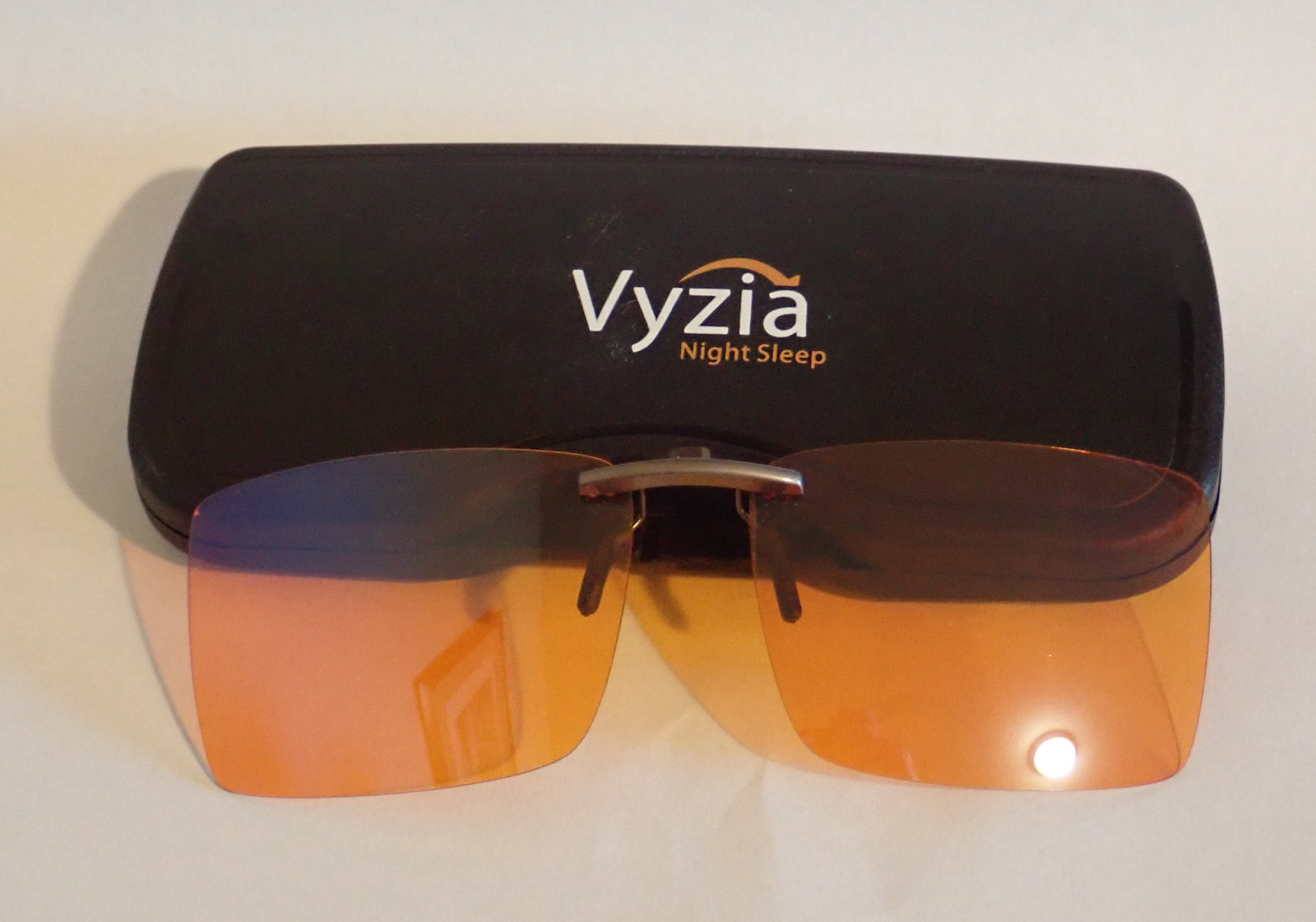
They’re fairly orange, and it shows. But they also cut the blue like a knife. On my house desktop, the Z27n, Ubuntu Night Shift pulled the blue light ratio down to 2.31% - which isn’t great. The Vyzia glasses, though? They cut it down to 0.34% by my calculations, and that’s a rather dramatic improvement on the built in night shift mode. You can still see some colors, too - it does a good job of hacking the spectrum in the areas that matter, sleep-wise, without cutting out the stuff that doesn’t matter.
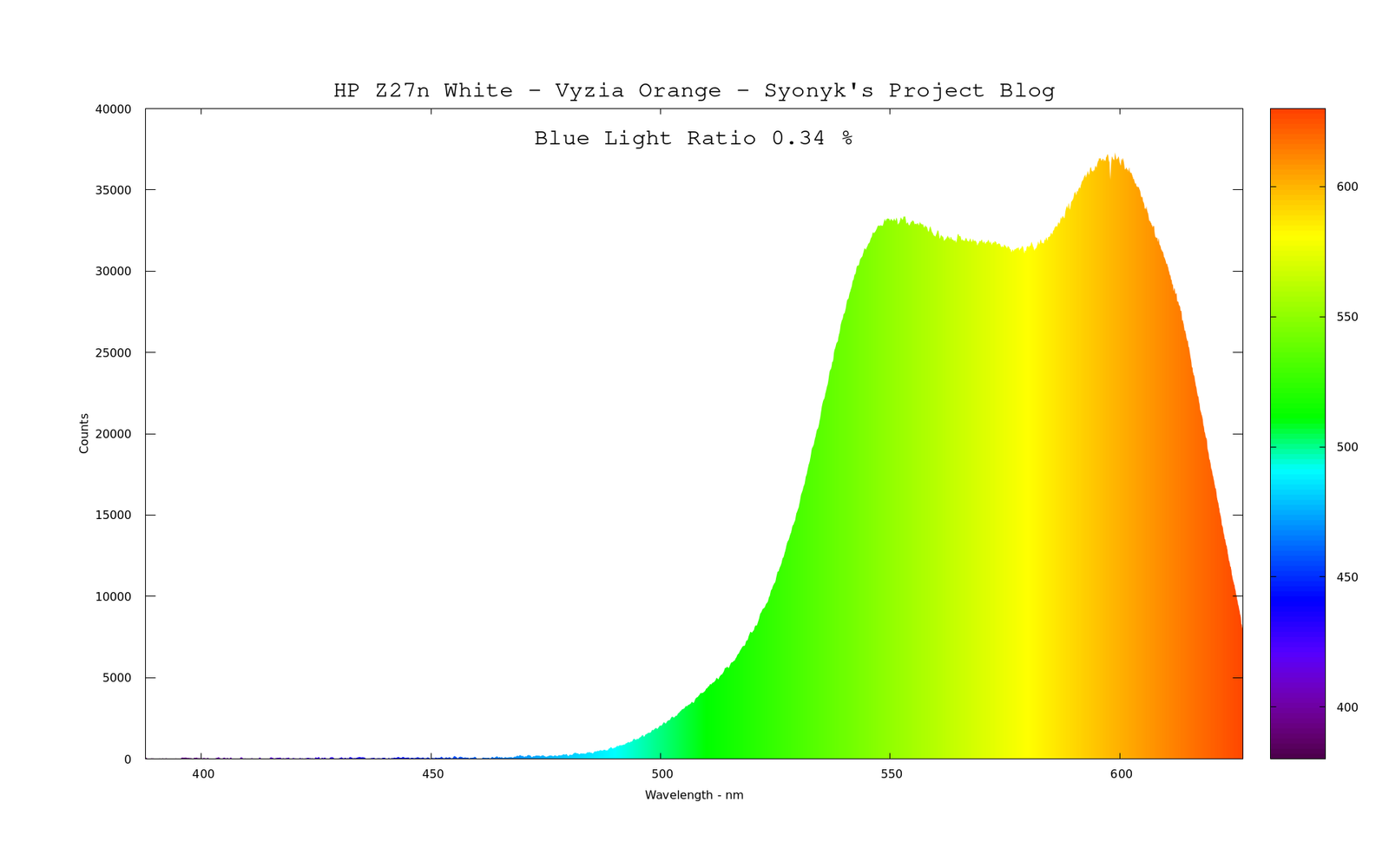
Against the X250’s stock white screen, it does an even better job, cutting the light down to 0.26%. These are staggeringly good numbers - and they’re against a day-white screen!
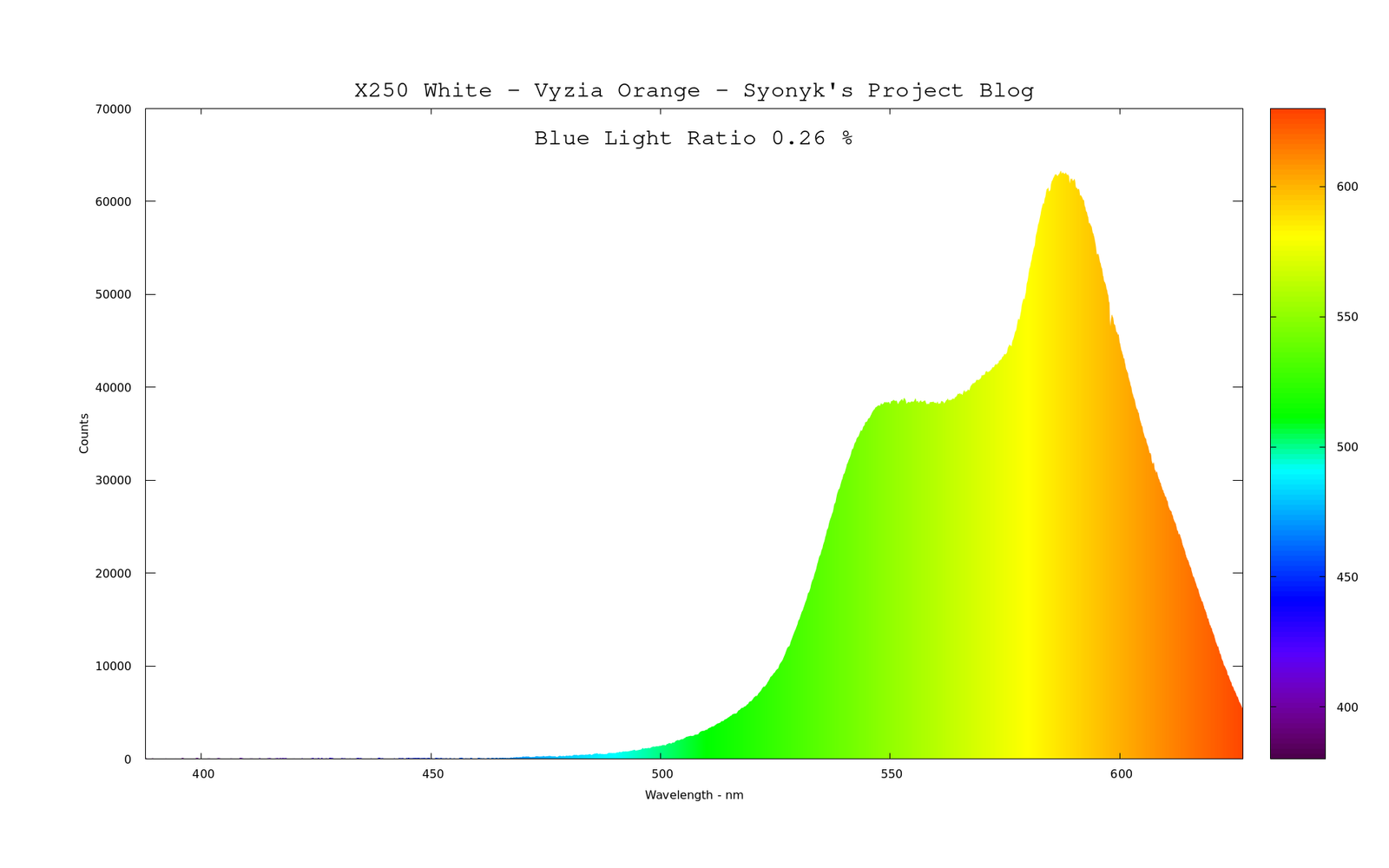
Against the already red shifted screen of the Ubuntu Night Light, you end up with about half the blue of the glasses alone - there’s just very little left down in the regions that interfere with sleep.
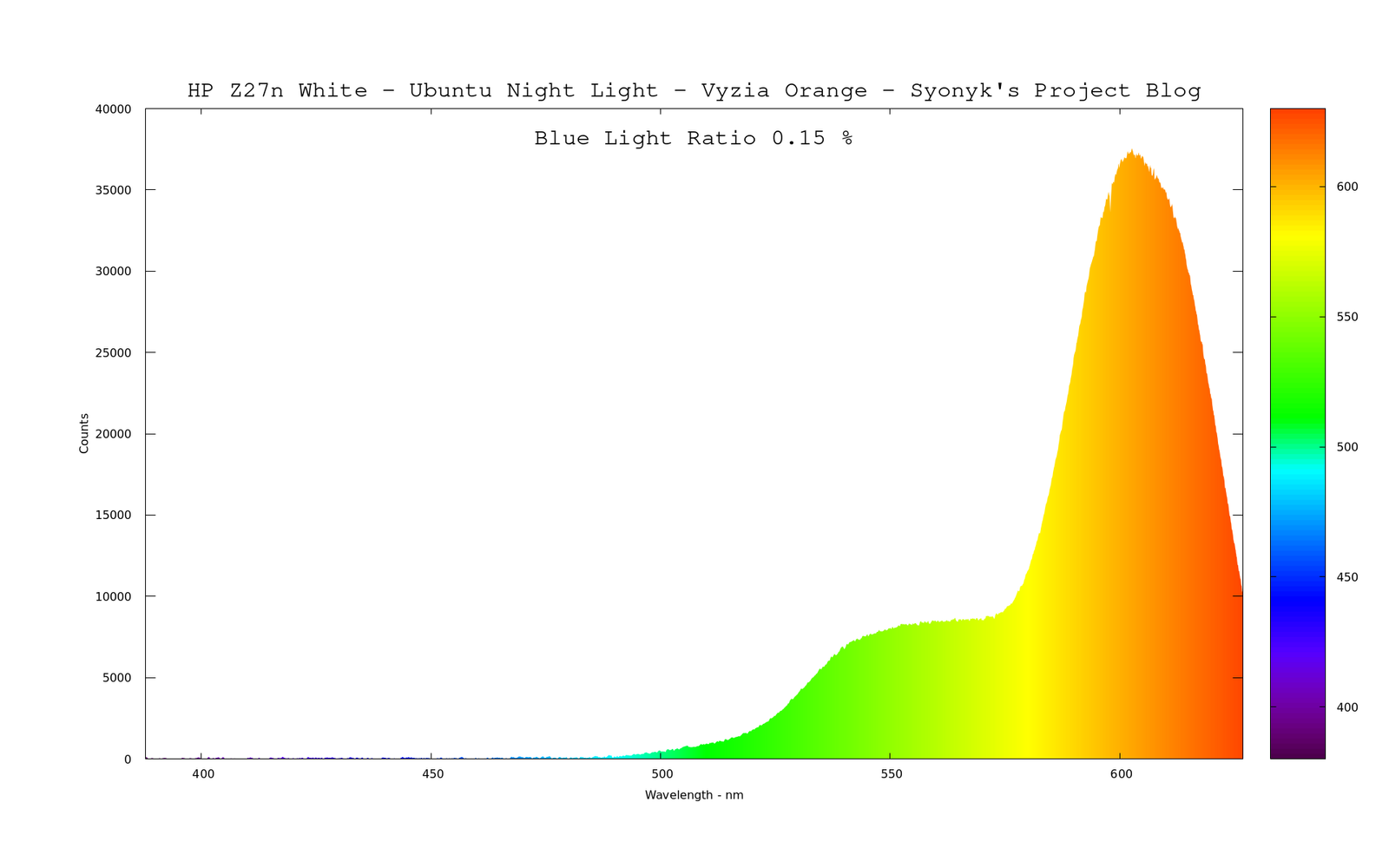
But on the X250 with Qubes and redshift, the elimination of the blue is complete - and then some. The remaining measurement down below about 525nm is just noise in my scope. Of course, the screen is also at this point almost entirely red. I wouldn’t do anything that depended on color with the system like this - but I can safely use it after dark without screwing with sleep.
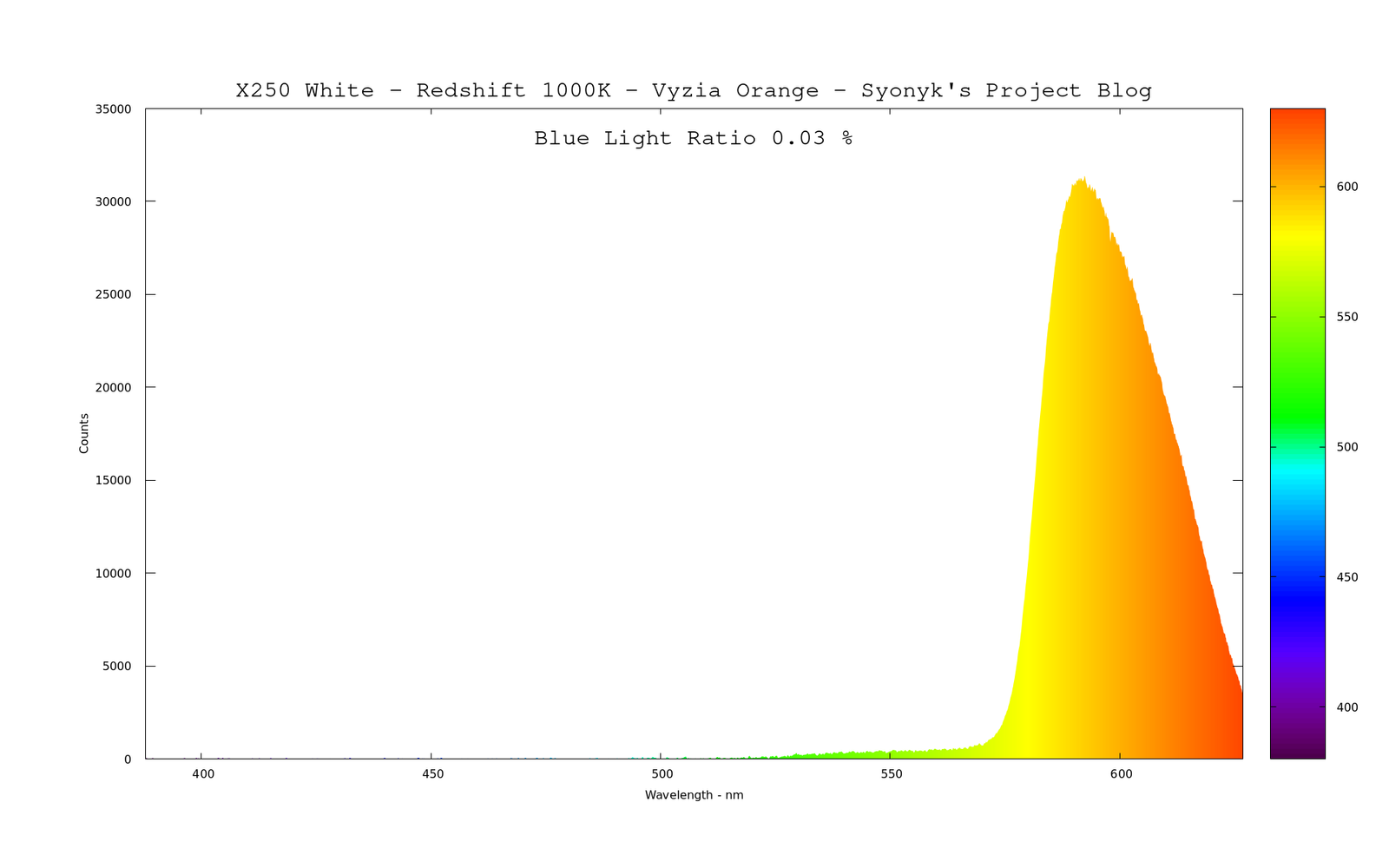
Paleo Tech Orange
Next, I want to look at the Paleo Tech orange goggles. These work fine over glasses, and are also usable with most glasses. They just have the problem of “not being any good,” as I’ll show you. They’re orange - yes. But despite that, they don’t manage to block enough blue to be particularly effective. They block some, but even before I put any of these through the spectrometer, I noticed that these didn’t seem to do anything sleep-related.
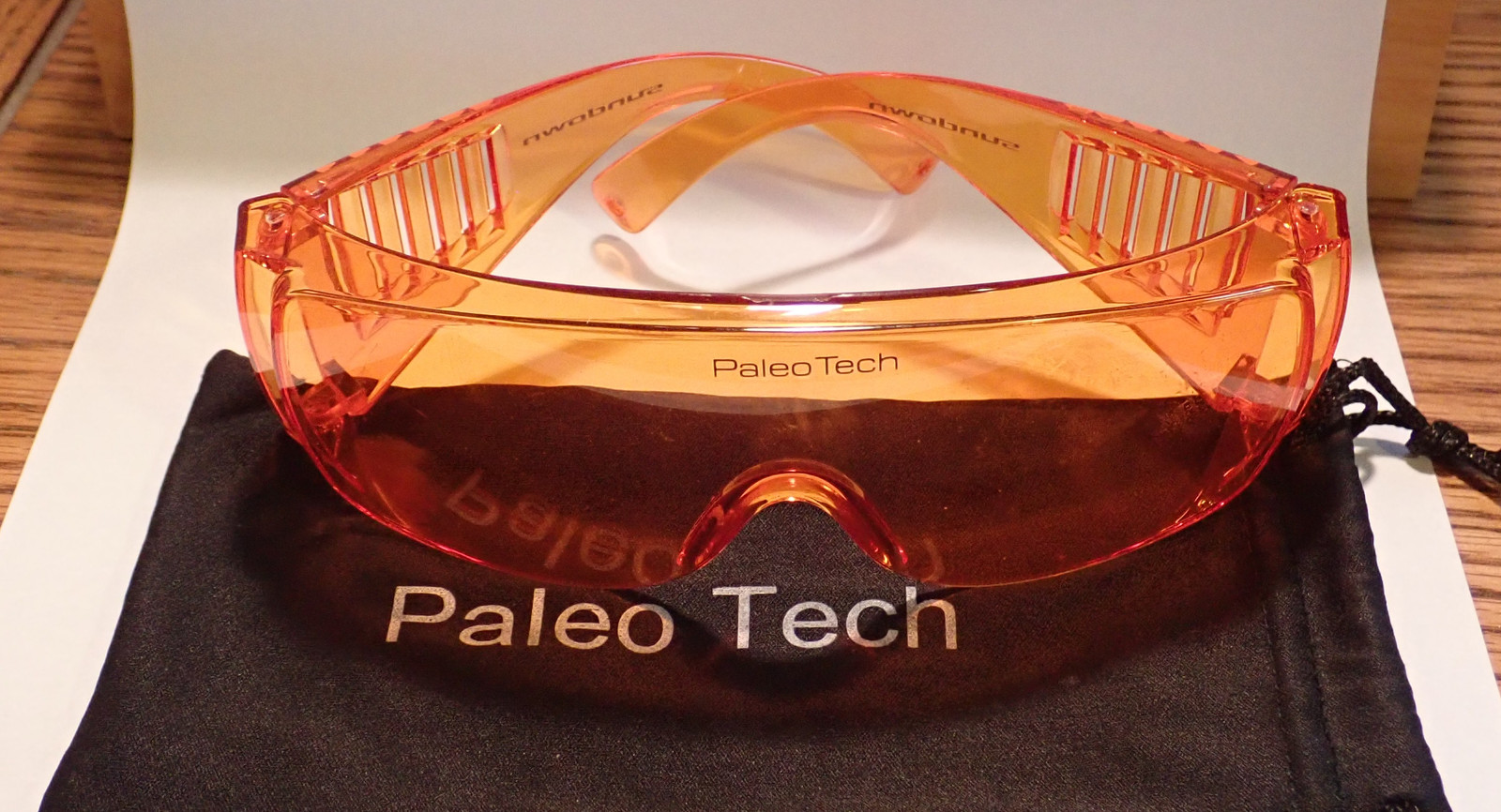
Against the full white HP display, they do block a bunch of the blue - but you can still see an awful lot of the blue leaking through down there in the 450-500nm range, and the blue light ratio shows it too.
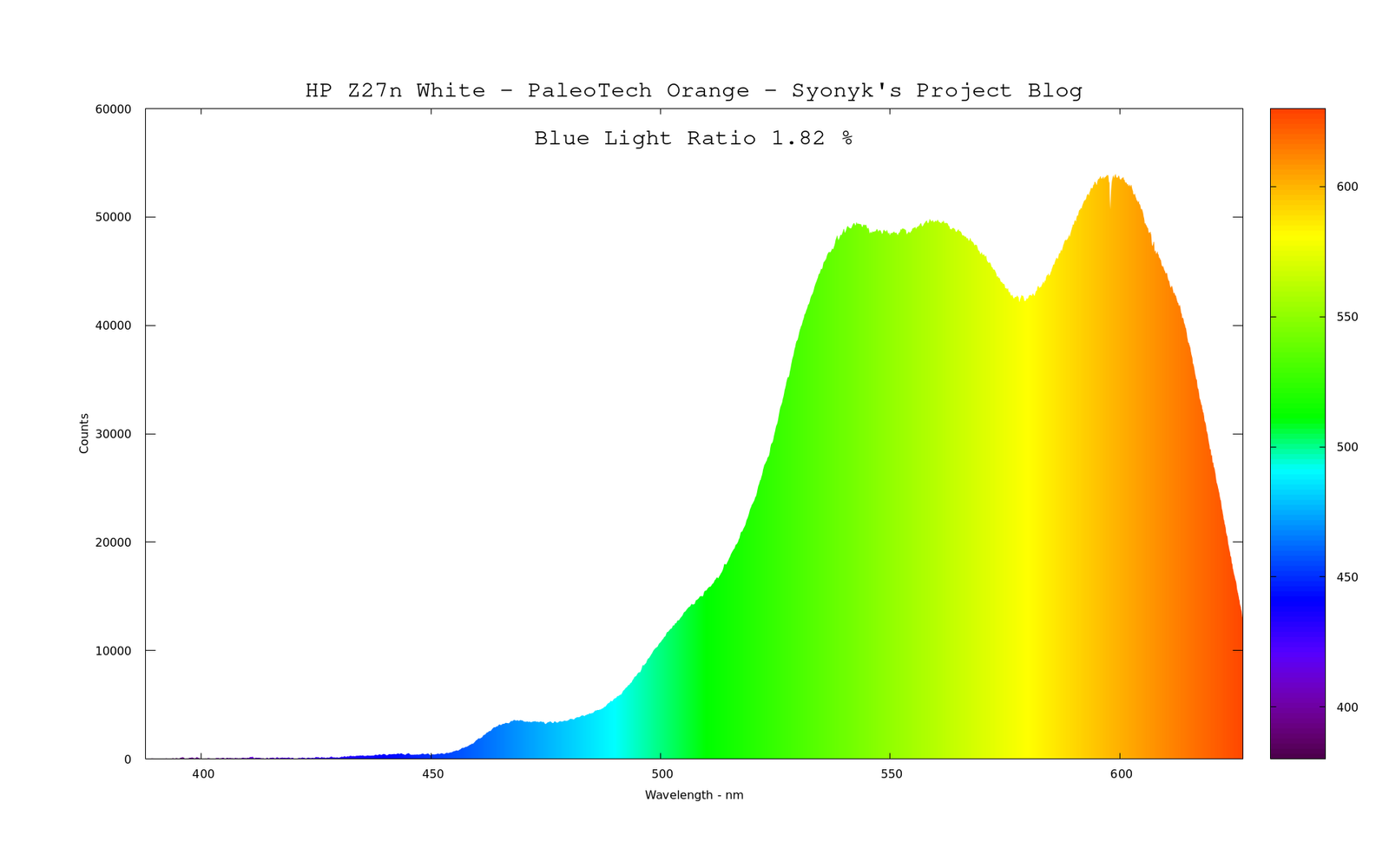
Against the X250, they’re even worse - they’re blocking something, but “all the blue” isn’t it.
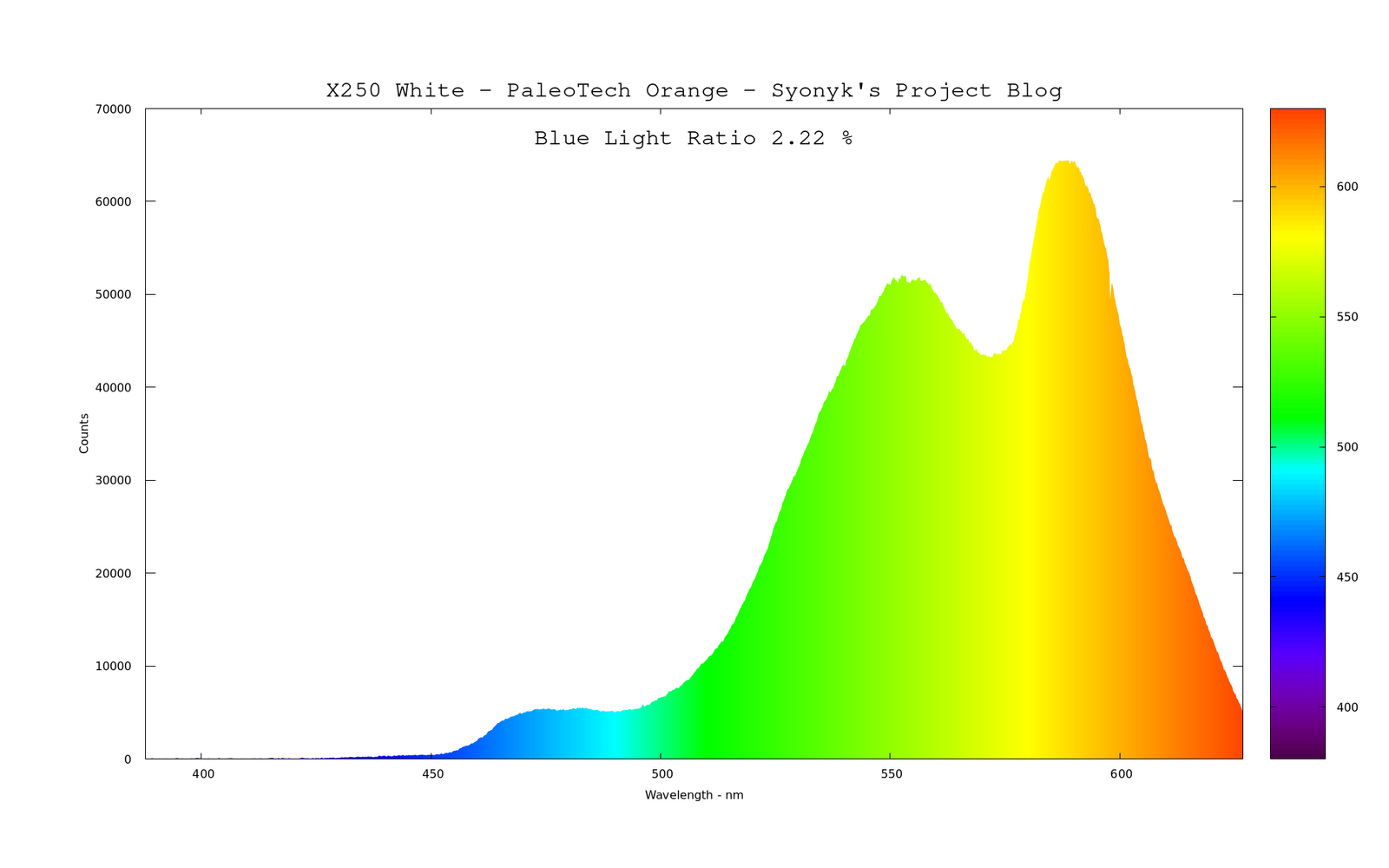
To further prove my point, when I have Ubuntu Night Light turned up full on the HP monitor, the PaleoTech Orange goggles let through a blue light ratio of 0.44%. This is certainly low compared to light bulbs - but the Vyzia pair managed 0.34% - against the full white monitor! Even with night shift turned on, these are worse than the Vyzias on a daytime screen.
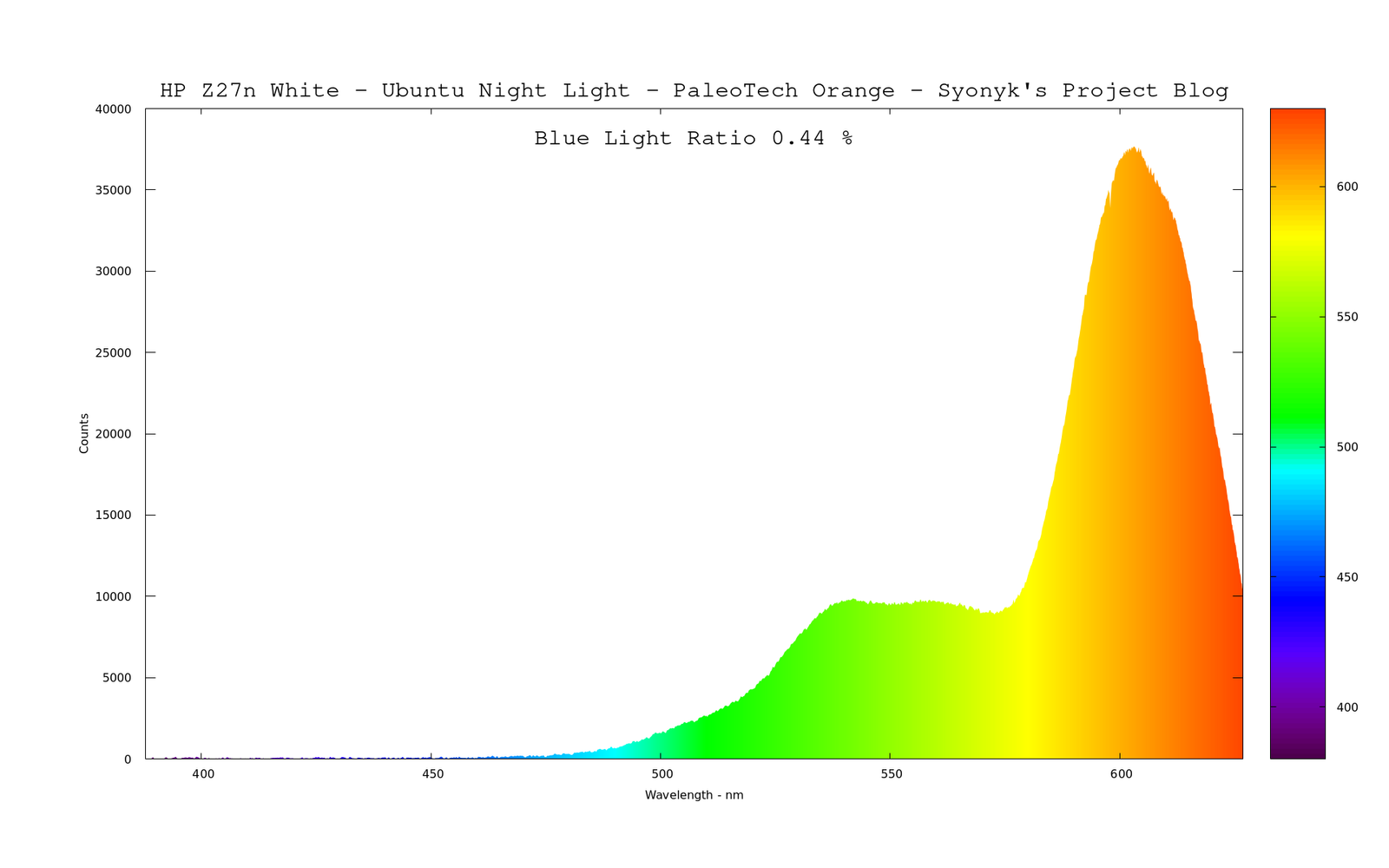
Now, I will say that against the 1000K X250 display, they do manage a decent job. I don’t see much but noise filtering through down in the bioactive regions. They’re not measuring quite as good here as the Vyzia lenses, but I also don’t think it matters - sub-0.10% is pretty darn low, regardless of how you get there. But their performance against the other displays leaves an awful lot to be desired. They look orange - I won’t argue. They just don’t manage to block the stuff that matters when you’re staring into a screen at night.
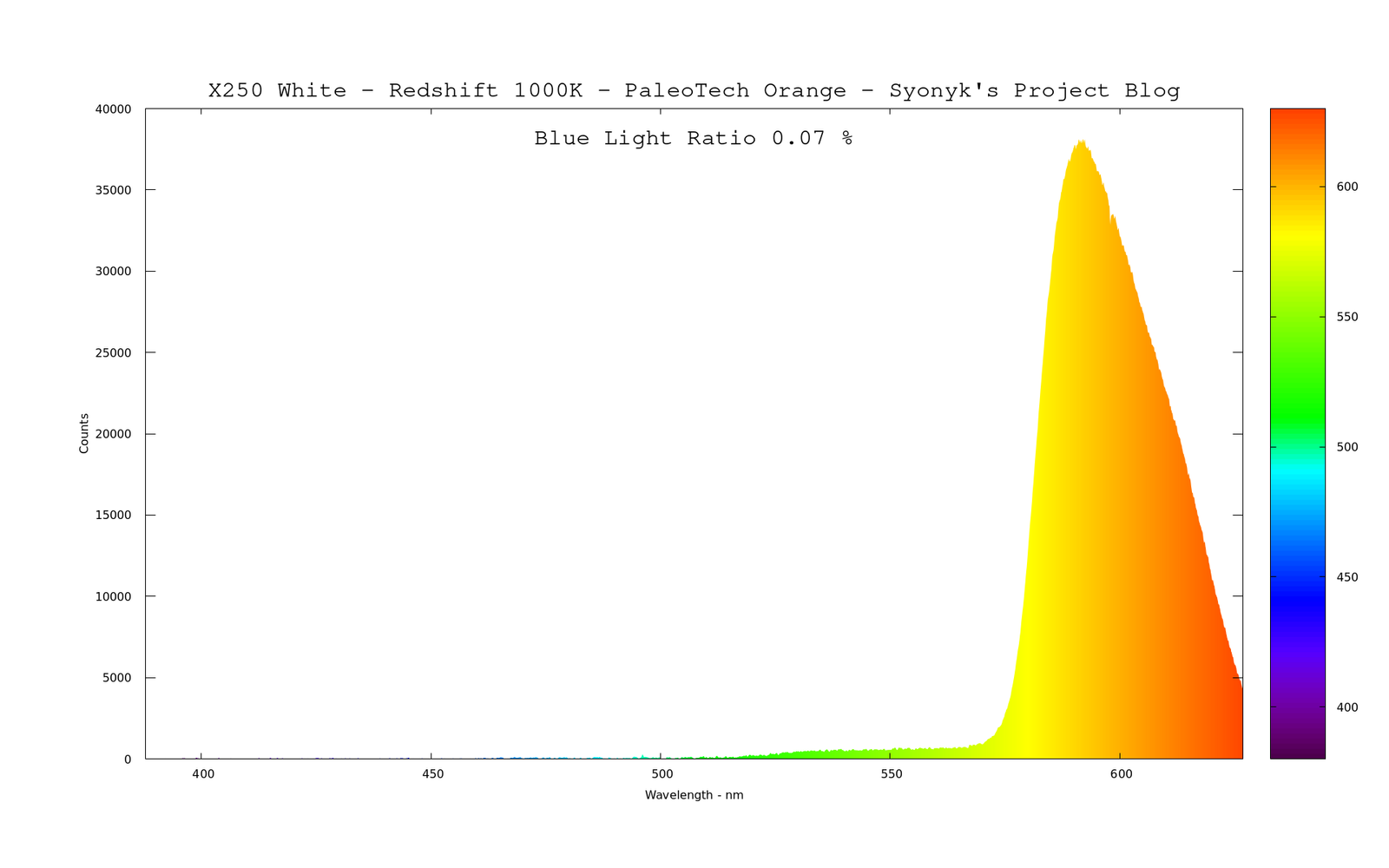
Paleo Tech Red
Finally, how about the red ones? These are very much red - your world turns nearly monochrome with them on, and it’s a fun effect to play with at times. But I’m not wearing these for art points - I’m wearing them to sleep after using screens at night.
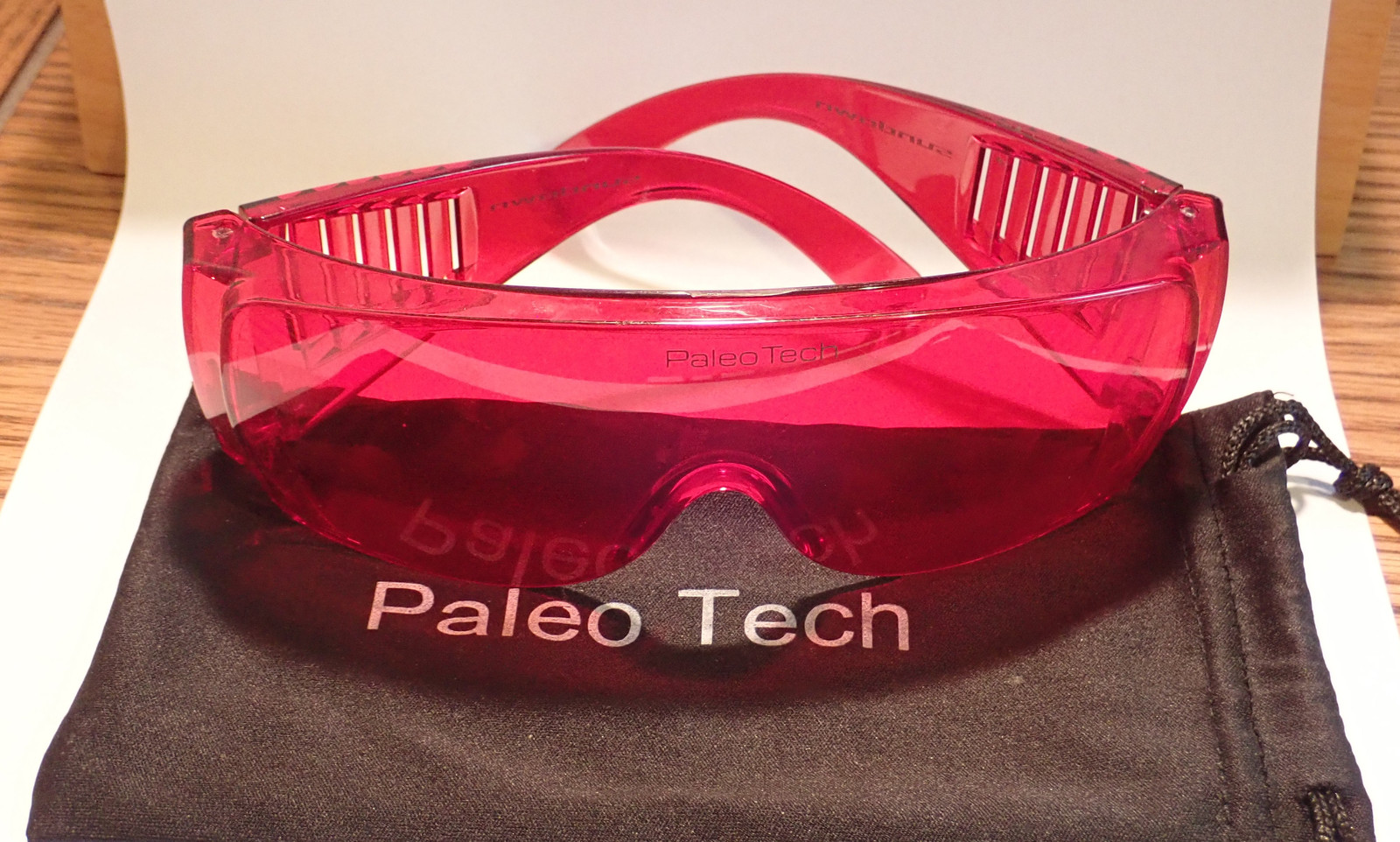
And, you know what? These, also, work. These are 100% blue blockers - and even more deeply than the Vyzias. The problem is that they also cut out a range of other useful frequencies in the process - frequencies that, as far as I can tell, don’t really matter with regards to sleep. You may as well have a bit more color perception in the evening if it doesn’t do any harm, and as I’ve shown, there are glasses that manage it, while allowing through a lot more of the spectrum than these do.
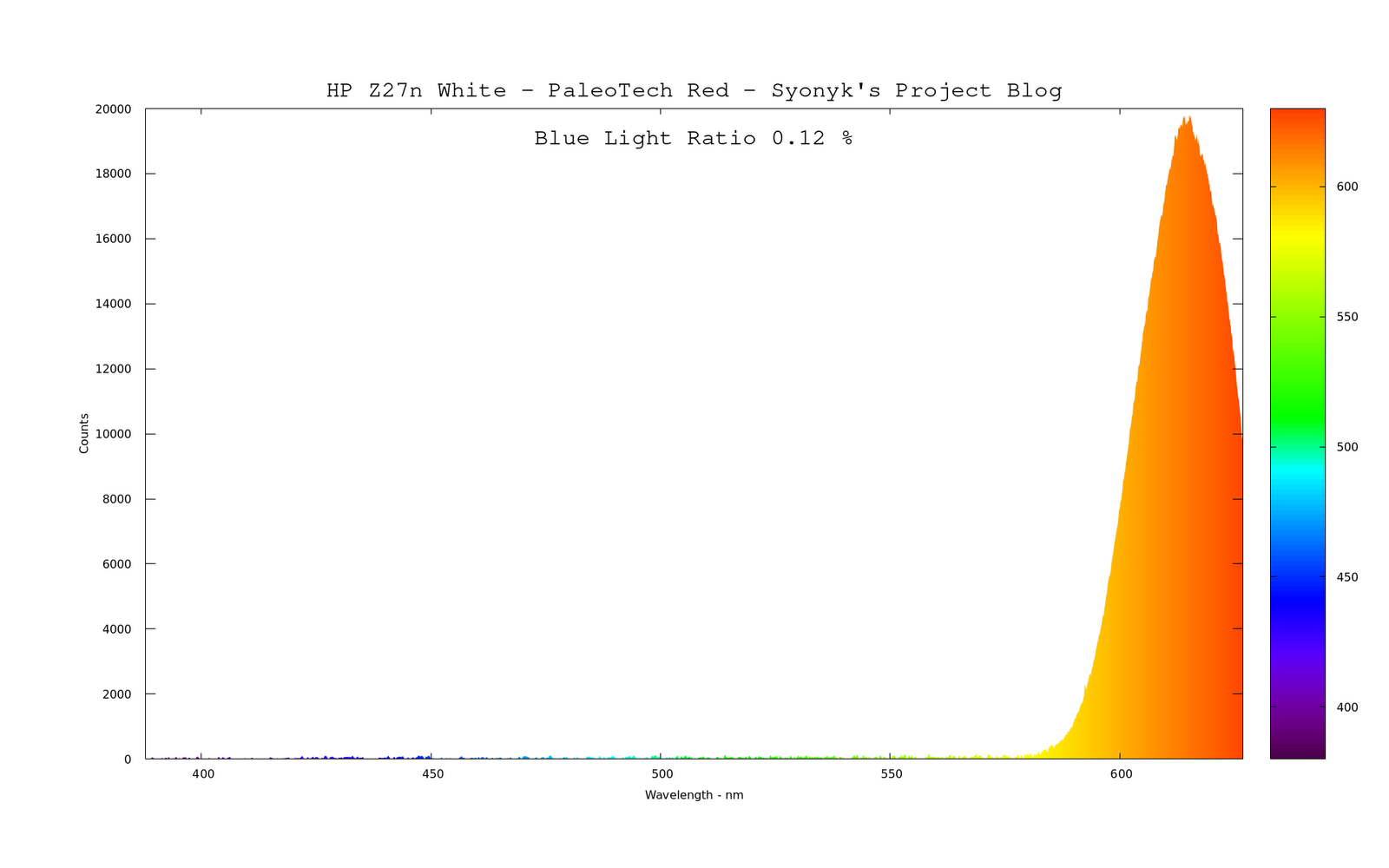
Against the laptop’s screen, similarly, they block everything that isn’t red. Your laptop is monochrome through these, and if that’s an effect you want, they work. But, again, they’re blocking stuff they don’t have to in order to get there.
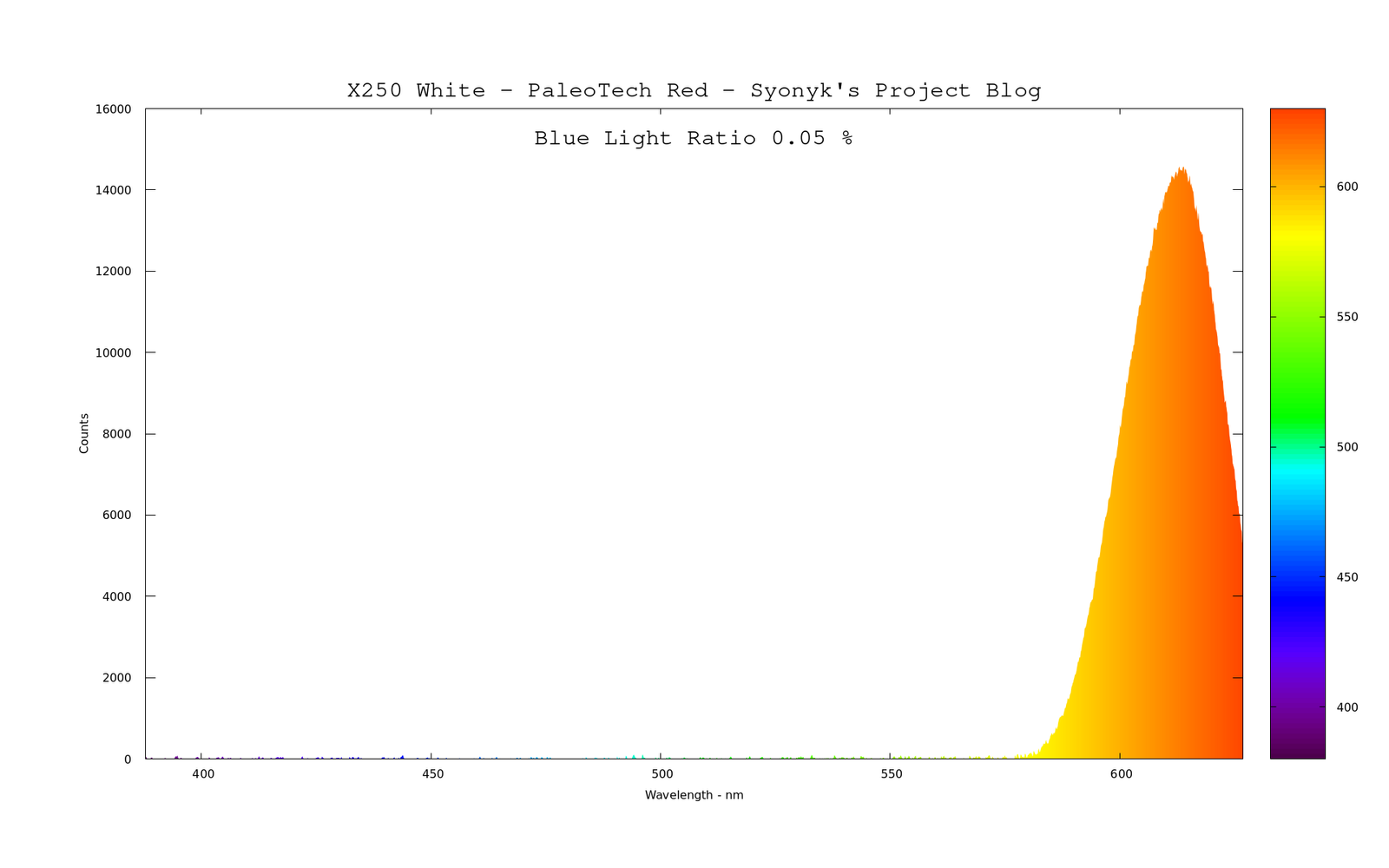
There’s no point in bothering with the red shifted screen charts - there’s simply nothing below about 575nm getting through these lenses.
The red ones work great - they just kill a lot of extra color in the deal. But you’re going to sleep fine, even with regular displays, through these!
Personal Experiments
In addition to the data I’ve collected, I’ve also been experimenting with these lenses personally. Since I’ve gotten used to how quickly I fall asleep when I’ve spent an evening reading a paper book with incandescent light sources (usually lanterns), it’s been interesting to try various other combinations in the evening and see if it makes a difference. I’d like to find some way to use a computer screen in the evening, though I don’t care nearly as much about it as I used to.
In short, the only thing I’ve found that works reasonably for me is dimming the screen as far as it goes, red shifting as hard as I can, and then using the Vyzia clip ons or the PaleoTech red glasses.
Night shift alone doesn’t change anything - the screen is still too bright, and too blue. Phones and tablets are worse, because they’re usually used at a shorter range than computer screens (at least desktop screens - I literally can’t reach my screens from how I normally sit) And long before I ran the goggles through the spectrometer, I was pretty confident that the PaleoTech orange glasses were nearly useless - they simply didn’t work in the evenings, and it would take a while to fall asleep if I’d been using them (even with a red shifted screen). So, at least my experiments aligns with the data!
Final Thoughts
To answer the early question I got regarding screens and blue goggles and such: Yes, a good set of blue blocking night lenses makes a real difference and can allow you to use a computer after sundown without messing with your sleep. Redshift hard, get a good set of lenses (Vyzia is my go-to), dim the screen as hard as you can, and it shouldn’t mess with your sleep terribly much.
But as I’ve shown, not all blue blocking lenses are equal. And without a spectrometer, it’s sure hard to tell which are any good. I’m done buying blue blocker lenses as I’ve found my set, but if you want to send me another set I’ll happily run them through the tests and get you the results back in exchange for being able to use the data in a future blog post.
The problem with this, of course, is that a lot of things people use computers for (games, anything slightly color sensitive, etc) simply doesn’t work well with this arrangement. You can set things up to safely use a computer for basic productivity tasks - reading, writing (this post has been written at night), basic sysadmin… most things that are text based work fine. And the rest? I’ll suggest you just shouldn’t bother with them after sundown. This setup is enough of a pain to discourage evening computer use, and I’m good with that.
But, seriously, if you wear glasses, get the Vyzia lenses (Amazon, eBay).
Comments
Comments are handled on my Discourse forum - you'll need to create an account there to post comments.If you've found this post useful, insightful, or informative, why not support me on Ko-fi? And if you'd like to be notified of new posts (I post every two weeks), you can follow my blog via email! Of course, if you like RSS, I support that too.
